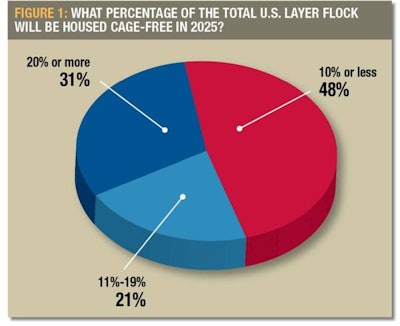
Today’s layer houses are true technological marvels, but economies of scale and the efficiencies of inline operation coupled with all of the automation, climate control and waste-handling equipment have worked to drive the cost of a new complex higher and higher.
When considering investments of tens of millions of dollars, the question of what type of housing to build, cages (enriched or enrichable) or cage-free (aviary with or without access to outdoors) becomes even more significant. In spite of uncertainty regarding what U.S. consumers will demand in the future, the U.S. egg industry is in the midst of a building boom.
Anecdotal feedback from equipment vendors and builders can be summarized this way: Business is very brisk and there are significant backlogs for equipment (cages and aviaries) and for construction crews.
Future U.S. layer housing
In Egg Industry’s annual Top Egg Company Survey, U.S. egg producers were asked what percent of the total U.S. table egg layer flock they expected to be housed in conventional cages, enriched cages and cage-free in 2025. There was a wide variation in the responses given by the 29 egg producers who answered this question, and I think that the data deserves another look.
The average response for what housing for layers would look like 10 years from now was 62, 24 and 14 percent in conventional cages, enriched cages and cage-free, respectively. Almost half, 14 of 29, of egg producers responding to the survey predicted that 10 percent or less of the total U.S. hen flock will be housed cage-free in 10 years (Figure 1). About one-third of egg producers, 9 of 29, predicted that 20 percent or more of the total U.S. layer flock will be housed cage-free in 2025.
U.S. egg producers don’t appear to be sold on enriched cages as the future housing of choice for layers in the U.S. Nearly two-fifths, 11 of 29, egg producers predicted that 10 percent or less of the total U.S. layer flock will be housed in enriched cages in 10 years (Figure 2). In contrast, only five egg producers expect more than half of the nation’s layer flock to be housed in enriched cages by 2025.
Around three quarters of egg producers responding to the survey, 22 of 29, predict that 50 percent or more of all hens will be housed in conventional cages in 2025 (Figure 3). Eleven egg producers expect 80 percent or more of all hens to be housed in conventional cages in 10 years. Very few egg producers see the U.S. layer industry making a rapid move out of conventional cages to either enriched cages or cage-free. In fact, only 10 percent predict that by 2025 less than 35 percent of the U.S. layer flock will be housed in conventional cages.
Expect more cage-free
The 31 egg producers who answered questions on planned expansion in 2015 house approximately 50 percent of the U.S. layer flock. These producers report that they will add housing for 10.8 million hens in total, with 35 percent of these being cage-free. It certainly appears that cage-free eggs will continue to gain market share in the U.S.


















